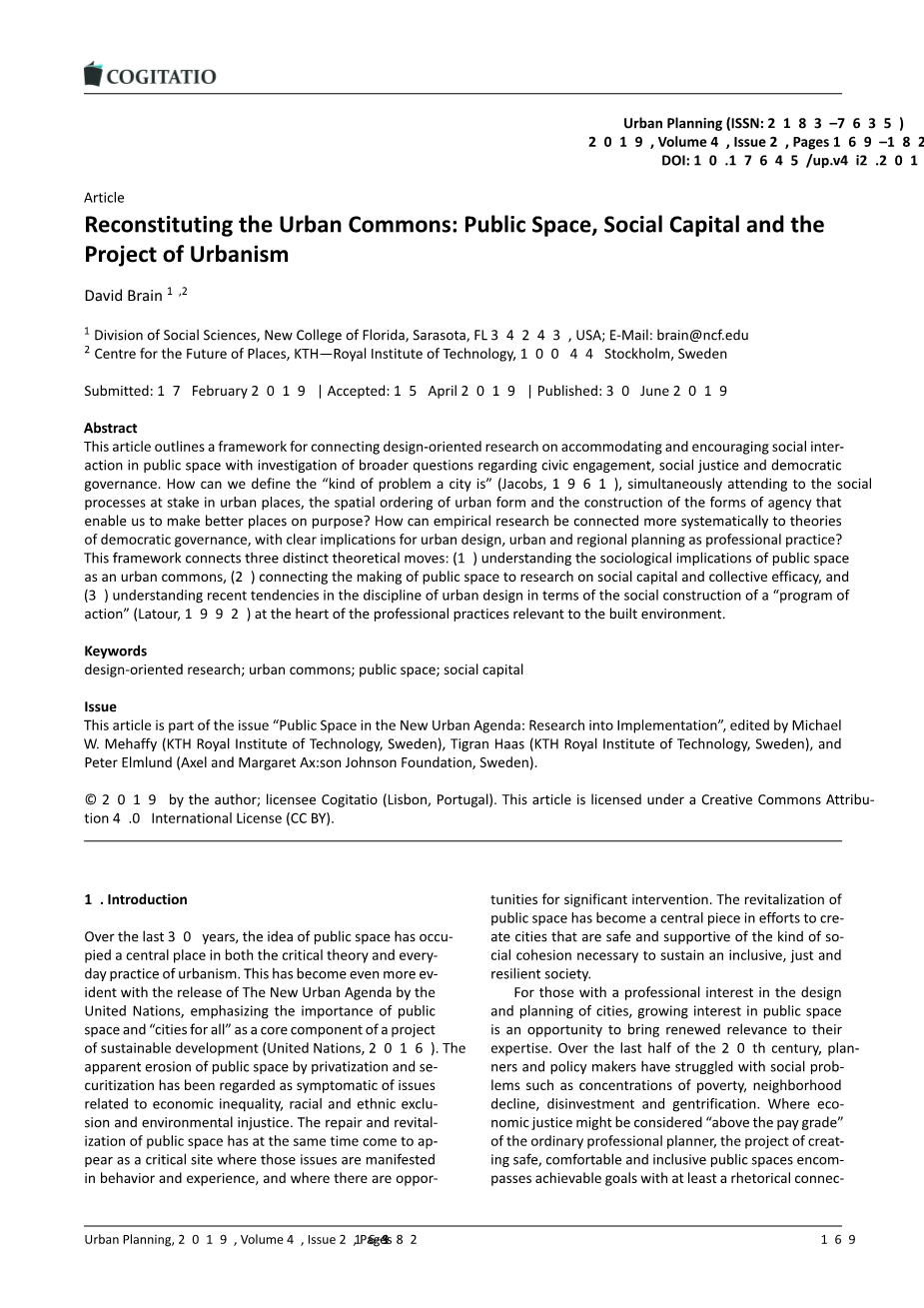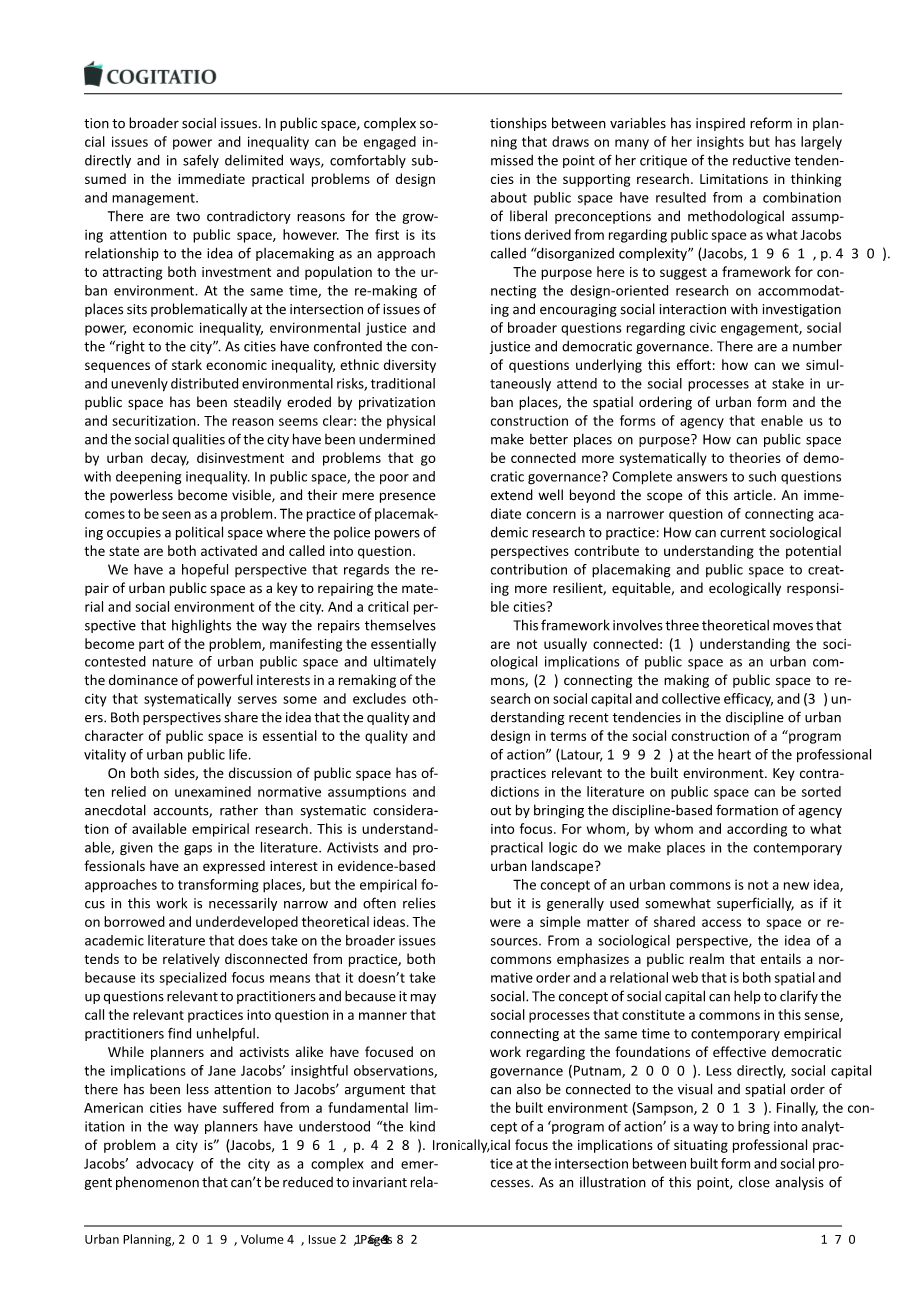

英语原文共 14 页,剩余内容已隐藏,支付完成后下载完整资料
目 录
Public Space as a Research Problem 3
Public Space as Civic Ecology 5
英文原文
Reconstituting the Urban Commons: Public Space, Social Capital and the Project of Urbanism(节选)
Introduction
Over the last 30 years, the idea of public space has occupied a central place in both the critical theory and every- day practice of urbanism. This has become even more evident with the release of The New Urban Agenda by the United Nations, emphasizing the importance of public space and “cities for all” as a core component of a project of sustainable development (United Nations, 2016). The apparent erosion of public space by privatization and securitization has been regarded as symptomatic of issues related to economic inequality, racial and ethnic exclusion and environmental injustice. The repair and revitalization of public space has at the same time come to ap- pear as a critical site where those issues are manifested in behavior and experience, and where there are opportunities for significant intervention. The revitalization of public space has become a central piece in efforts to create cities that are safe and supportive of the kind of social cohesion necessary to sustain an inclusive, just and resilient society.
For those with a professional interest in the design and planning of cities, growing interest in public space is an opportunity to bring renewed relevance to their expertise. Over the last half of the 20th century, planners and policy makers have struggled with social problems such as concentrations of poverty, neighborhood decline, disinvestment and gentrification. Where economic justice might be considered “above the pay grade” of the ordinary professional planner, the project of creating safe, comfortable and inclusive public spaces encompasses achievable goals with at least a rhetorical connection to broader social issues. In public space, complex social issues of power and inequality can be engaged in- directly and in safely delimited ways, comfortably subsumed in the immediate practical problems of design and management.
There are two contradictory reasons for the growing attention to public space, however. The first is its relationship to the idea of placemaking as an approach to attracting both investment and population to the urban environment. At the same time, the re-making of places sits problematically at the intersection of issues of power, economic inequality, environmental justice and the “right to the city”. As cities have confronted the con- sequences of stark economic inequality, ethnic diversity and unevenly distributed environmental risks, traditional public space has been steadily eroded by privatization and securitization. The reason seems clear: the physical and the social qualities of the city have been undermined by urban decay, disinvestment and problems that go with deepening inequality.
We have a hopeful perspective that regards the re-pair of urban public space as a key to repairing the mate- rial and social environment of the city. And a critical perspective that highlights the way the repairs themselves become part of the problem, manifesting the essentially contested nature of urban public space and ultimately the dominance of powerful interests in a remaking of the city that systematically serves some and excludes others. Both perspectives share the idea that the quality and character of public space is essential to the quality and vitality of urban public life.
Public Space as a Research Problem
Michael Sorkin introduces a volume on the erosion of public space with this claim: “The familiar spaces of traditional cities, the streets and squares, courtyards and parks, are our great scenes of the civic, visible and accessible, our binding agents” (Sorkin, 1992, p. xv). Such claims are often the justification but not the focus of re- search on public space. The most well-known research on public space falls along a line that runs from Jane Jacobsrsquo; anecdotes to William Whytersquo;s methodical observation of “the social life of small urban spaces” (Whyte, 1980). Throughout the literature, the concept of public space contains a useful but problematic ambiguity, as discussions slip from physical space to interactional space, and from an image of public sociability as characterized by Jacobs and others to an image of the idea of the “public realm” as a distinct field of social action (Arendt, 1958; Weintraub, 1995). These conceptions cut across political perspectives on the “grand dichotomy” of public and private, from the liberal/economistic distinction between the state and civil society to the “republican virtue” tradition that regards the public realm in terms of “political community and citizenship, analytically distinct from both the market and the administrative state” (Weintraub amp; Kumar, 1997, p. 7). This last move—from public space to the public realm—reflects the ways in which ideas about public sp
剩余内容已隐藏,支付完成后下载完整资料
资料编号:[254710],资料为PDF文档或Word文档,PDF文档可免费转换为Word
您可能感兴趣的文章
- 通过在消费者心中树立品牌关系导向来提高酒店品牌绩效外文翻译资料
- “友好“抱怨行为:走向亲密的手段外文翻译资料
- 服务蓝图:针对关键服务流程的有效方法-在四星级国际酒店Arash Shahin 管理部进行案例研究外文翻译资料
- 组织中女性高管职业生涯规划与晋升的视角:连锁性别偏见的经验,双重束缚,和不成文的晋升规则外文翻译资料
- 影响优秀员工工作满意度的激励因素识别外文翻译资料
- 探索离职意向的影响因素:以豪华酒店员工为例外文翻译资料
- 新冠肺炎疫情下,中国酒店旅游业面临的挑战与机遇外文翻译资料
- 酒店Twitter账号的营销效果:以沙特阿拉伯为例外文翻译资料
- 酒店旅游市场营销外文翻译资料
- 中国经济型酒店SWOT分析外文翻译资料


